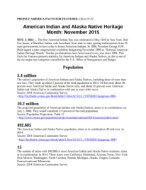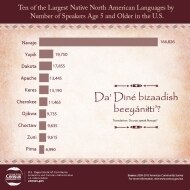Facts for Features: American Indian and Alaska Native Heritage Month: November 2015
The first American Indian Day was celebrated in May 1916 in New York. Red Fox James, a Blackfeet Indian, rode horseback from state to state, getting endorsements from 24 state governments, to have a day to honor American Indians. In 1990, President George H.W. Bush signed a joint congressional resolution designating November 1990 as “National American Indian Heritage Month.” Similar proclamations have been issued every year since 1994. This Facts for Features presents statistics for American Indians and Alaska Natives, as this is one of the six major race categories classified by the U.S. Office of Management and Budget.
Graphic [PDF <1.0MB]
Population
5.4 million
The nation’s population of American Indians and Alaska Natives, including those of more than one race. They made up about 2 percent of the total population in 2014. Of this total, about 48 percent were American Indian and Alaska Native only, and about 52 percent were American Indian and Alaska Native in combination with one or more other races.
Source: 2014 American Community Survey
<//factfinder.census.gov/bkmk/table/1.0/en/ACS/14_1YR/S0201//popgroup~009>
10.2 million
The projected population of American Indians and Alaska Natives, alone or in combination, on July 1, 2060. They would constitute 2.4 percent of the total population.
Source: Population Projections, Table 11
<//www.census.gov/population/projections/data/national/2014/summarytables.html>
492,605
The American Indian and Alaska Native population, alone or in combination, 65 and over, in 2014.
Source: 2014 American Community Survey
<//factfinder.census.gov/bkmk/table/1.0/en/ACS/14_1YR/S0201//popgroup~009>
15
The number of states with 100,000 or more American Indian and Alaska Native residents, alone or in combination, in 2014. These states were California, Oklahoma, Arizona, Texas, New York, New Mexico, Washington, North Carolina, Florida, Michigan, Alaska, Oregon, Colorado, Pennsylvania and Minnesota.
Source: 2014 American Community Survey
<//factfinder.census.gov/bkmk/table/1.0/en/ACS/14_1YR/S0201/0100000US.04000/popgroup~009>
19.4%
The proportion of Alaska’s population identified as American Indian and Alaska Native, alone or in combination, in 2014, the highest share for this race group of any state. Alaska was followed by Oklahoma (13.5 percent), New Mexico (10.4 percent), South Dakota (10.1 percent) and Montana (8.0 percent). The estimates for New Mexico and South Dakota were not significantly different from one another.
Source: 2014 American Community Survey
<//factfinder.census.gov/bkmk/table/1.0/en/ACS/14_1YR/DP05/0100000US.04000>
31.4
The median age for those who were American Indian and Alaska Native, alone or in combination, in 2014. This compares with a median age of 37.7 for the U.S. population as a whole.
Source: 2014 American Community Survey
<//factfinder.census.gov/bkmk/table/1.0/en/ACS/14_1YR/S0201//popgroup~009>
Reservations
326
The number of federally recognized American Indian reservations in 2015. All in all, excluding Hawaiian Home Lands, there are 630 American Indian and Alaska Native legal and statistical areas for which the Census Bureau provides statistics.
Source: Census Bureau Geography Division
<https://www.census.gov/geo/reference/gtc/gtc_aiannha.html>
Tribes
566
The number of federally recognized Indian tribes in 2015.
Source: Bureau of Indian Affairs, 2015
<//www.bia.gov/cs/groups/public/documents/text/idc1-029079.pdf>
Families
1,788,853
The number of American Indian and Alaska Native households in 2014 (households with a householder who was American Indian and Alaska Native alone or in combination with another race). Of these, 37.8 percent were married-couple families, including those with children.
Source: 2014 American Community Survey
<//factfinder.census.gov/bkmk/table/1.0/en/ACS/14_1YR/S0201//popgroup~009>
6.0%
The percentage of American Indians and Alaska Natives, alone or in combination with other races, age 30 and over, who were grandparents living with at least one of their grandchildren in 2014.
Source: 2014 American Community Survey
<//factfinder.census.gov/bkmk/table/1.0/en/ACS/13_3YR/S0201//popgroup~009>
Housing
53.0%
The percentage of single-race American Indian and Alaska Native householders who owned their own home in 2014. This is compared with 63.1 percent of the overall population.
Source: 2014 American Community Survey
<//factfinder.census.gov/bkmk/table/1.0/en/ACS/14_1YR/S0201//popgroup~006>
Languages
26.8%
The percentage of single-race American Indians and Alaska Natives, age 5 and older who spoke a language other than English at home in 2014, compared with 21.1 percent for the nation as a whole.
Source: 2014 American Community Survey
<//factfinder.census.gov/bkmk/table/1.0/en/ACS/14_1YR/S0201//popgroup~006>
Education
82.4%
The percentage of American Indians and Alaska Natives alone or in combination, 25 and older, who had at least a high school diploma, GED certificate or alternative credential in 2014. In addition, 18.5 percent obtained a bachelor’s degree or higher. In comparison, 86.9 percent of the overall population, 25 and older, had a high school diploma or higher, and 30.1 percent had a bachelor’s degree or higher.
Source: 2014 American Community Survey
<//factfinder.census.gov/bkmk/table/1.0/en/ACS/14_1YR/S0201//popgroup~009>
39.7%
The percentage of single-race American Indians and Alaska Natives, 25 and older, with a bachelor’s degree or higher whose degree was in science and engineering, or science and engineering-related fields, in 2014. This compares with 43.9 percent for all people 25 and older with a bachelor’s degree or higher.
Sources: 2014 American Community Survey
<//factfinder.census.gov/bkmk/table/1.0/en/ACS/14_1YR/C15010C>
<//factfinder.census.gov/bkmk/table/1.0/en/ACS/14_1YR/C15010>
13.9%
The percentage of single-race American Indians and Alaska Natives, 25 and older, who had a bachelor’s, graduate or professional degree in 2014.
Source: 2014 American Community Survey
<//factfinder.census.gov/bkmk/table/1.0/en/ACS/14_1YR/S0201//popgroup~006>
Businesses
274,238
The number of American Indian and Alaska Native owned firms in 2012.
Source: Survey of Business Owners-American Indian and Alaska Native Owned Firms: 2012
<//factfinder.census.gov/bkmk/table/1.0/en/SBO/2012/00CSA01>
Note: The preliminary company summary provides estimates for the number of firms, receipts, employment and payroll by gender, ethnicity, race and veteran status at the U.S., state and sector levels. The final businesses and business owners will be released in December 2015.
Jobs
26.3%
The percentage of civilian-employed, single-race American Indian and Alaska Native people, 16 and older, who worked in management, business, science and arts occupations in 2014. In addition, 25.6 percent worked in service occupations and 22.3 percent in sales and office occupations. The percentage in management, business, science and arts occupations was not significantly different from the percentage in service occupations.
Source: 2014 American Community Survey
<//factfinder.census.gov/bkmk/table/1.0/en/ACS/14_1YR/S0201//popgroup~006>
Veterans
140,556
The number of single-race American Indian and Alaska Native veterans of the U.S. Armed Forces in 2014.
Source: 2014 American Community Survey
<//factfinder.census.gov/bkmk/table/1.0/en/ACS/14_1YR/B21001C>
Income and Poverty
$37,227
The median household income of single-race American Indian and Alaska Native households in 2014. This compares with $53,657 for the nation as a whole.
Source: 2014 American Community Survey
<//factfinder.census.gov/bkmk/table/1.0/en/ACS/14_1YR/S0201//popgroup~006>
28.3%
The percentage of single-race American Indians and Alaska Natives who were in poverty in 2014, the highest rate of any race group. For the nation as a whole, the poverty rate was 15.5 percent.
Sources: 2014 American Community Survey
<//factfinder.census.gov/bkmk/table/1.0/en/ACS/14_1YR/S0201//popgroup~006>
<//factfinder.census.gov/bkmk/table/1.0/en/ACS/14_1YR/S0201>
Health Insurance
23.1%
The percentage of single-race American Indians and Alaska Natives who lacked health insurance coverage in 2014. For the nation as a whole, the corresponding percentage was 11.7 percent.
Source: 2014 American Community Survey
<//factfinder.census.gov/bkmk/table/1.0/en/ACS/14_1YR/S0201//popgroup~006>
The following is a list of observances typically covered by the Census Bureau’s Facts for Features series:
| Black (African American) History Month (February) Super Bowl Valentine's Day (Feb. 14) Women's History Month (March) Irish-American Heritage Month (March)/ St. Patrick's Day (March 17) Earth Day (April 22) Asian/Pacific American Heritage Month (May) Older Americans Month (May) Mother's Day Hurricane Season Begins (June 1) Father's Day |
The Fourth of July (July 4) Anniversary of Americans With Disabilities Act (July 26) Back to School (August) Labor Day Grandparents Day Hispanic Heritage Month (Sept. 15-Oct. 15) Unmarried and Single Americans Week Halloween (Oct. 31) American Indian/Alaska Native Heritage Month (November) Veterans Day (Nov. 11) Thanksgiving Day The Holiday Season (December) |
Editor’s note: The preceding data were collected from a variety of sources and may be subject to sampling variability and other sources of error. Facts for Features are customarily released about two months before an observance in order to accommodate magazine production timelines. Questions or comments should be directed to the Census Bureau’s Public Information Office: telephone: 301-763-3030; or e-mail: [email protected].





